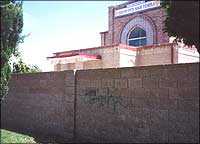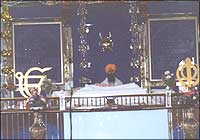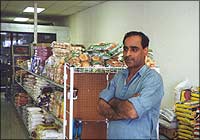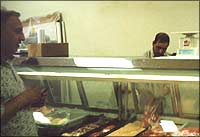The Rediff US Special/Sukhjit Purewal, India Abroad
Taking stock of Stockton
Under the piercing sun of a late spring day in Stockton, California, a man in tattered clothes pushes a shopping cart teeming with bags of treasured recyclables on South Grant Street, just steps from the Stockton gurdwara.
Across the street in the other direction sit boarded-up homes. Directly behind the gurdwara is the weed-infested presence of the Union Pacific railroad track. To keep the blight and the malfeasance of the south side of Stockton at a safe distance, the gurdwara constructed an austere brick fence all along the exterior of the building last year.

|
|
The brick wall around the Stockton gurdwara
| |
As Giani Surinder Singh explains, the wall was needed because worshippers could look out onto the street and see drug deals taking place. Still, a smattering of graffiti leaves an indelible mark on the bricks, a reminder that the world has changed a lot since the gurdwara first opened its doors as a gathering place for Northern California's Sikhs.
It was in 1915 when the house that originally stood at 1936 S Grant Street was converted into a gurdwara and became the first Sikh temple in the United States. The temple was made possible by the dedication of a group of Sikh farmers who came to be known as the Sikh Unit after they came together in 1911 and began raising money to open a gurdwara. Fifteen years later, the brick gurdwara, which still stands, was constructed at a cost of $35,000.

|
|
Giani Parminder Singh reads from the Guru Granth
Sahib inside the gurdwara
| |
Latest census figures show that there are 2,270 Indians living in Stockton, less than 1 per cent of the city's overall population of 243,771. The same thing applies to San Joaquin County, where Indians make up less than 1 per cent of the population.
Asians account for nearly 20 per cent of the city's population and nearly 11 per cent of the county. The county's overall population jumped from 480,628 in 1990 to 563,598 in 2000.
The Asian Indian population in California has soared in the past 10 years by 97 per cent -- from 159,973 in 1990 to 314,819 in 2000. According to the 2000 Census, Asian Indians are the fastest-growing group among the various Asian communities in California. In terms of numbers, Indians are the sixth largest Asian group in California, after the Chinese (980,642), Filipino (918,678), Vietnamese (447,032), Other Asian (401,606) and Korean (345,882). California's total population increased by 14 per cent from 29.8 million in 1990 to 33.9 million in 2000.

|
|
Mohammed Rafiq at his Halal Meat Market
| |
Nationwide the Asian Indian population in the US nearly doubled in the last decade to 1.7 million. Indians have replaced the Japanese as the third largest Asian group behind the Chinese and Filipinos. Asians in California grew by nearly 35 per cent in the past decade and now represent about 11 per cent of the state's residents.
Stockton was one of the locations where Punjabis who came to work on the railroads settled. Later the temple was the destination for Sikh families who drove to the gurdwara from miles around to pray on Sundays, before they built temples in their own communities.
But as Stockton and San Joaquin County have grown, so has the diversity of the residents. Today Stockton has two mosques, one that is home to 500 worshippers and a second that holds about 80 people. There is even a third mosque that is used by Arab Muslims.
"There are so many more Indians," exclaims Avtar Sohal, a Stockton resident for 26 years. "It is not the same Stockton I used to know," she adds, as she punches out the change from the register for a customer at the Sohal Mini-Mart on South El Dorado Avenue.

|
|
Benjamin Prasad takes a time out at the Sohal Mini-Mart
| |
Benjamin Prasad, a Fiji native who is affectionately called 'Fuji', was busy stocking soda in the mini-mart refrigerator.
"The city hasn't changed," says Prasad, who has lived in Stockton off and on for 35 years. The spirit of Stockton remains the same, but the physical growth has been astronomical, he explains.
At the other end of town, in India Bazaar market on Hammer Lane, shopper Santosh Sharma echoes Sohal's sentiments. Fifteen years ago, when Sharma moved to Stockton, her shopping choices were rather limited. "There was just one store," Sharma says as she gazes at items from shelf to shelf.
Just across the street from India Bazaar, several Muslim worshippers who have just completed an afternoon prayer service at the smaller mosque on Hammer Lane follow Mohammed Rafiq back to his shop, Halal Meat Market.
Rafiq moved to Stockton almost two years ago and opened his shop. He says his customers are "mostly Muslim, mostly Indian". And Rafiq said he couldn't be happier that the numbers of Muslims are only increasing.

|
|
Mohammed Khan helps a customer at the Halal Meat
Market
| |
Although there seems to be little new industry in the city itself, Rafiq said agricultural work in the San Joaquin Valley continues to be a source of income for newly arrived Indians who don't speak English.
But the Indians who were interviewed for this story also pointed to a new factor in the equation: Stockton is becoming a viable option for individuals fleeing the high rental prices of the Bay Area. But the influx towards the relatively affordable homes in San Joaquin County can only mean one thing.
"Property prices are rising so much," complains Sohal, dropping her shoulders in exasperation.
That leaves longtime Stockton residents like Bob Dare, Rafiq's friend who occasionally tends to the register, wondering what will happen to him and others in similar situations.
"I don't know where we will go."
(Aseem Chhabra contributed to this story.)
Related Stories:
Asian Indian Population Doubles In a Decade
Saris and Spices: The Changing Face of New York
Back to top
Tell us what you think of this report